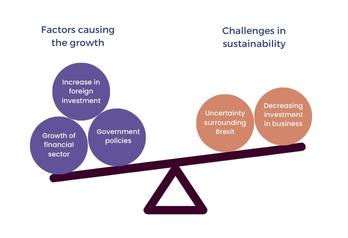Describe the revival of industrial and commercial productivity in the UK and assess how long-lasting the current trend might be
Tagged: Business and management
The resurgence of industrial and commercial productivity in the U.K. has been a topic of interest to investors and senior managers. After years of decline, the U.K. has seen a resurgence in productivity, with a growth rate of 0.7% in 2018 (Office for National Statistics, 2019). This essay aims to provide a broad perspective on the resurgence of industrial and commercial productivity in the U.K. and determine how sustainable this new trend may be. Additionally, the U.K. and U.S. will be compared to highlight the effects of different country-specific factors. Finally, the essay will focus on providing valuable information to investors and senior managers.
The Resurgence of Industrial and Commercial Productivity in the U.K.The U.K. has seen a revival in industrial and commercial productivity in recent years. The growth rate of the U.K. economy has been higher than that of other major European economies, such as Germany and France (Office for National Statistics, 2019). The increase in productivity has been attributed to several factors.
One significant factor is the growth of the U.K.'s services sector, which has accounted for over 80% of the U.K.'s GDP growth in recent years (H.M. Government, 2019). This growth has been driven by the rise of technology and digitalization, making it easier for businesses to offer services across borders. The U.K.'s financial services sector, which accounts for over 6% of the economy's growth, also counts as a factor for economic revival.
Another factor contributing to the U.K.'s productivity growth is the increase in foreign investment. The U.K. has become an attractive destination for foreign investors due to its highly skilled workforce, stable political environment, and access to the European market. In 2018, the U.K. attracted over $50 billion in foreign investment (United Nations Conference on Trade and Development, 2019).
Furthermore, the U.K. government has implemented policies to boost productivity, such as investing in infrastructure, research and development, and education and training. For example, the government has invested in transport infrastructure, such as the High-Speed 2 rail link, to improve connectivity and reduce travel times between major cities. The government has also increased funding for research and development, which led to the creation of new products and technologies.
Sustainability of the New TrendWhile the U.K.'s productivity growth has been impressive, the sustainability of this trend is a matter of concern. One potential obstacle to sustained productivity growth is the uncertainty surrounding Brexit. The departure of the U.K. from the European Union has created uncertainty for businesses, particularly those that rely on trade with the EU. Moreover, the uncertainty surrounding Brexit has led to a decline in business investment, which could hamper productivity growth in the long term (Office for Budget Responsibility, 2019).
Another challenge to sustained productivity growth is the skills shortage in the U.K. labour market. While the U.K. has a highly skilled workforce, there is a paucity of workers skilled in science, technology, engineering, and mathematics (STEM) sector. This shortage could limit the growth of sectors such as technology and manufacturing, which rely heavily on workers with STEM skills.
 Comparison of the U.K. and U.S.
Comparison of the U.K. and U.S.
The U.K. and the U.S. can be compared to understand the effects of different country-specific factors on productivity growth. The U.S. has experienced sustained productivity growth for several decades and has consistently ranked higher than the U.K. in measures of productivity. One factor contributing to the U.S.'s productivity growth is its large and dynamic market, enabling businesses to benefit from economies of scale and innovation.
Another factor contributing to the U.S.'s productivity growth is its flexible labour market. The U.S. labour market is more flexible than the U.K.'s, with fewer regulations on hiring and firing. This flexibility has enabled businesses to respond quickly to changes in demand and has facilitated the growth of industries such as technology.
However, the U.S. also faces challenges to sustained productivity growth. One challenge is the increasing income inequality, which has led to a decline in consumer demand and a slowdown in economic growth. Another challenge is the skill shortage, particularly in STEM fields, which has limited the growth of industries such as technology.
ConclusionIn conclusion, the U.K. has seen a return of industrial and commercial productivity recently, driven by factors like the growth of the services sector, foreign investment, and government policies. However, the sustainability of this trend is uncertain, given the challenges posed by Brexit and the skills shortage in the U.K. labour market. A comparison of the U.K. and U.S. highlights the effects of different country-specific factors on productivity growth. Investors and senior managers should be aware of these factors when making investment and business decisions.

